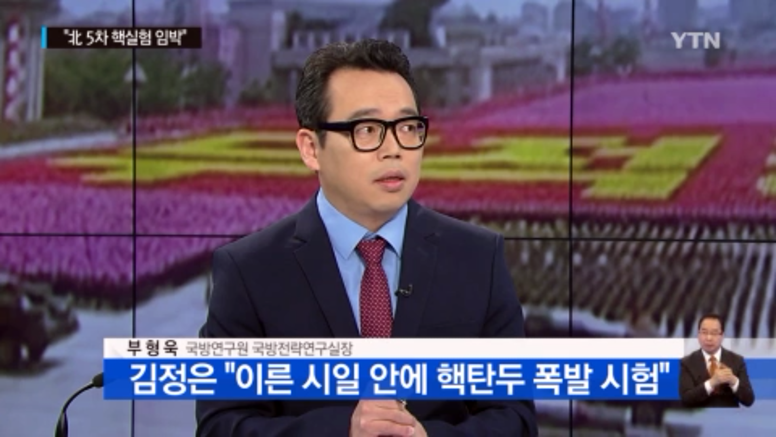This series is written in the style of a series of periodical articles, not that of a newspaper article.
[The following article is part one of a four-part series on THAAD (Terminal High Altitude Area Defense), a missile defense system soon to be stationed in South Korea.]
A 90% dysfunctional government. Several hundred thousand people dead in Seoul. Millions more injured. With emergency response system and medical facilities gone, the injured and dying are left to fend for themselves. North Korean troops pour down through several valleys across the DMZ in the absence of organized resistance. A heated debate takes place in the White House as to whether America should retaliate by launching a nuclear strike of its own on Pyongyang on behalf its ally, South Korea. Millions of South Korean refugees stream south, clogging up every inch of the freeways, highways and country roads. The surviving South Korean military units struggle their ways against the flow of refugees to meet the North Korean forces. China issues an ultimatum that any nuclear attack on Pyongyang by the United States would be regarded as an act of war against China.

[Photo by U.S. Missile Defense Agency June 28, 2010
- The Missile Defense Agency and U.S. Army soldiers successfully conducting
an intercept test for THAAD off the island of Kauai, Hawaii.]
This is one possible scenario among many that defense analysts both in Korea and America have developed in the face of nuclear threat from North Korea. Although the likelihood of a nuclear war on Korean peninsula is low according to the military experts, all agree that the nuclear capability in the hands of an abnormal state like North Korea poses an existential threat to South Korea. A nuclear detonation in South Korea with its tiny landmass and overwhelming population density would instantly render the nation non-functioning.
Such danger presented by North Korea’s growing nuclear program led to the South Korean government’s announcement in July, 2016, of the deployment of Terminal High Altitude Area Defense (THAAD) on its soil. This decision, however, drew immediate criticism from the liberal politicians domestically and objections from China and Russia. This article examines the North Korean nuclear threat and the need for THAAD. The follow up articles will examine the reasons behind North Korea’s nuclear ambition, the domestic and international objections and, finally, the South Korean government’s choice on the deployment of THAAD.
North Korean nuclear threat
There has been an ever-growing list of North Korean nuclear provocations over the last several years. These include five nuclear tests (two of which have occurred this year), the alleged development of a “hydrogen bomb,” and various medium and long-range missile tests. They have been accompanied by bellicose rhetoric against South Korea, as well as the U.S. and her allies.
North Korea also claims that it has successfully “miniaturized” the nuclear warheads. If true, it would have dire implications for South Korea--a “miniaturized” nuclear warhead can be mounted on medium-range missiles already in the North Korean arsenal. The miniaturization technology is an extremely challenging one and, historically, only a handful of technologically developed nations have achieved it. Although “it is believed to be that North Korea is around 3-4 years away from being able to [miniaturize warheads],” according to Professor Boo Hyung-wook at Korea National Defense University, the threat posed by miniaturization is now one that South Korea and its allies must give sufficient credence to.

Perhaps, the most recent and possibly most dangerous development in North Korea’s nuclear ambition is its successful submarine-launched ballistic missile (“SLBM”) test in late August. This development is particularly dangerous since it is extremely difficult to detect submarines. From the perspective of South Korea’s defense posture, it faces the daunting problem of not knowing which direction North Korean submarine-launched missiles may come from, rendering its land-based missile defense systems impotent.
With the convergence of these technological developments, experts agree that the North Korean nuclear threat is now real. The South Korean government’s decision to bring in THAAD is a direct response to this threat.
THAAD
Having first entered development in 2008, THAAD is an anti-missile missile system designed to intercept ballistic missiles during their terminal phase (i.e. when they come down towards the earth). THAAD’s AN/TPY-2 radar detects the launch of an enemy missile and tracks its trajectory. The system’s fire control and support system is engaged and launches its interceptor missile. The interceptor missile flies at a speed over Mach 8, giving it a hypersonic mobility to intercept the incoming missile at as high an altitude as possible during its terminal phase.
A similar system called the Patriot Advanced Capability has already been stationed in the South since 2004. According to Professor Boo, however, THAAD operates at an engagement altitude of about 150 kilometers, while Patriot takes down missiles at an altitude of 15-40km. THAAD’s considerable range gives it up to a 130 second window of opportunity to take down an incoming ballistic missile. This is much greater than that of Patriot, which is approximately 40 seconds. In other words, THAAD provides an additional layer of anti-missile defense with an ability to intercept an incoming missile earlier and at a higher altitude before PAC-3 can engage it. In the context of North Korea’s growing nuclear capabilities, the South Korean government felt that THAAD was necessary to ensure the safety of the nation.
Article-2 will examine the reasons behind North Korea’s nuclear ambition.

Andrew Chung
11th grade
Seoul Foreign School
THAAD Article 2 : North Korea’s Nuclear Ambition
http://www.heraldinsight.co.kr/news/articleView.html?idxno=378
THAAD Article 3 : Oppositions to THAAD Deployment
http://www.heraldinsight.co.kr/news/articleView.html?idxno=383
By Andrew Chung

